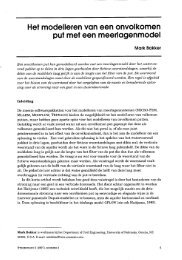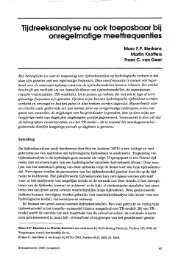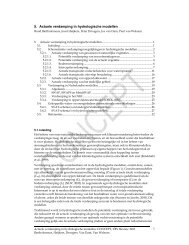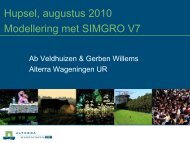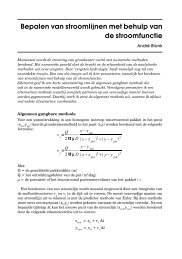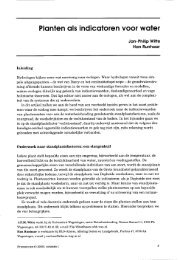PDF Viewing archiving 300 dpi - NHV.nu
PDF Viewing archiving 300 dpi - NHV.nu
PDF Viewing archiving 300 dpi - NHV.nu
You also want an ePaper? Increase the reach of your titles
YUMPU automatically turns print PDFs into web optimized ePapers that Google loves.
5. SPATIAL VARIABILITY WITHIN A PRECIPITATION FIELD<br />
From our own experiences we know that the spatial distribution of precipitation can<br />
be highly irregular. The meteorological processes responsible for this variability were<br />
reviewed this morning by Schmidt (1976).<br />
To illustrate the possible differences over a short distance, the spatial distribution of<br />
the daily precipitation amounts is shown in Figure 3, as measured on May 24, 1972, with<br />
a dense network installed in Salland, a district in the eastern part of the Netherlands, in<br />
1970-1972. This was done within the framework of a hydrological research programme<br />
(Santing et al., 1974).<br />
In this figure the same precipitation field is drawn as "seen" by the (less denser)<br />
national rain gauge network of the Royal Netherlands Meteorological Institute.<br />
This example shows that, over distances of 1 kilometre, differences of 20 mm/day can<br />
occur.<br />
Generally, these differences within areas such as Salland are not systematic. For most<br />
of the practical applications, areas in the Netherlands of, say, 1000 krn2 can largely be<br />
considered to be climatologically homogeneous and isotrope.<br />
It will be pointed out in the next section that a convenient quantity to describe the<br />
statistical spatial structure of a precipitation field is the correlation coefficient, p, defined<br />
by:<br />
in which the bars indicate an average over a long time series; hi and hk are the precipitation<br />
depth measured at the ith and kth station, while oi and ok are the standard deviations<br />
(of time series) of these stations.<br />
If the distance between the two stations is denoted by rik, it is to be expected that<br />
pik decreases with increasing rik, if a homogeneous and isotrope area is considered.<br />
It has been found (see e.g. St01 (1972) and De Bruin, (1975) that the "correlation<br />
function", p(r), can be (more or less) satisfactorily described by:<br />
which relationship can be written for r





